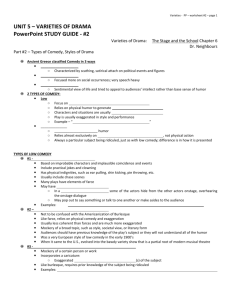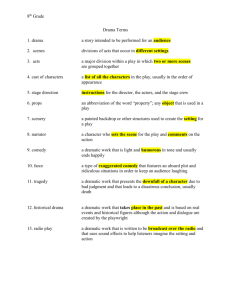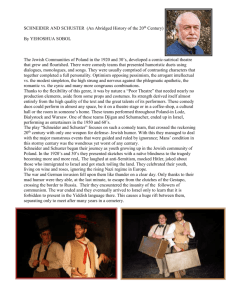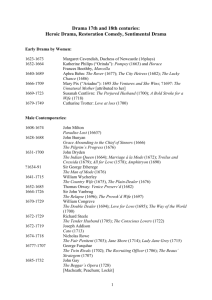Varieties of Drama
advertisement
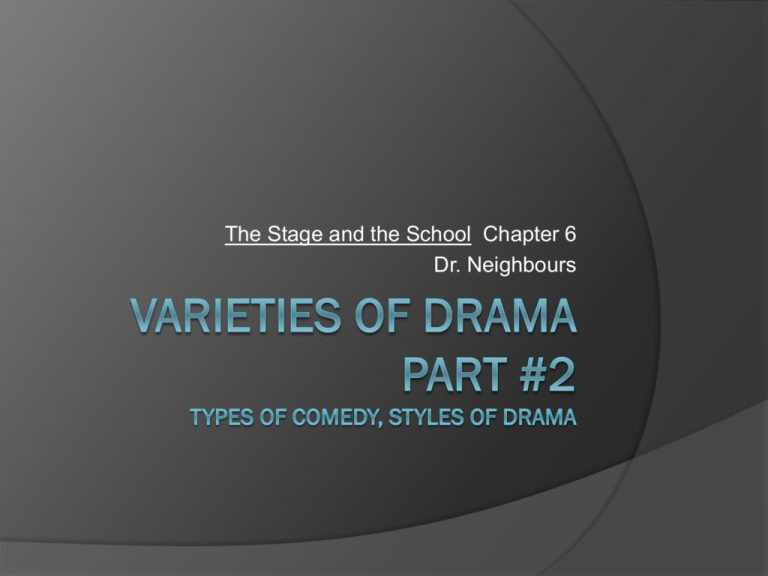
The Stage and the School Chapter 6 Dr. Neighbours Ancient Greece classified Comedy in 3 ways Old Characterized by scathing, satirical attach on political events and figures Middle Focused more on social occurrences; very speech heavy New Sentimental view of life and tried to appeal to audiences’ intellect rather than base sense of humor 2 TYPES OF COMEDY: Low High Focus on physical antics Relies on physical humor to Intellectual humor Relies almost exclusively on generate laughter Characters and situations are usually outlandish Play is usually exaggerated in style and performance Example – “The Three Stooges” witty dialogue, not physical action Always a particular subject being ridiculed, just as with low comedy; difference is in how it is presented TYPES OF LOW COMEDY #1 - Farce Based on improbable characters and implausible coincidence and events Include practical jokes and clowning Has physical indignities, such as ear pulling, shin kicking, pie throwing, etc. Usually include chase scenes Many plays have elements of farce May have screen scenes In a screen scene some of the actors hide from the other actors onstage, overhearing the onstage dialogue May pop out to say something or talk to one another or make asides to the audience Examples: The three stooges TV: Third Rock from the Sun, Arrested Development Neil Simon’s Rumors Some SNL skits: ○ http://www.youtube.com/w atch?v=1IohU9u6baw #2 – Burlesque (European Burlesque) Not to be confused with the Americanization of Burlesque Like farce, relies on physical comedy and exaggeration Usually less coherent than farces and are much more exaggerated Mockery of a broad topic, such as style, societal view, or literary form Audiences should have previous knowledge of the play’s subject or they will not understand all of the humor Was a very European style of low comedy in the early 1900’s When it came to the U.S., evolved into the bawdy variety show that is a partial root of modern musical theatre #3 - Parody Mockery of a certain person or work Incorporates a caricature: Exaggerated feature(s) of the subject Like burlesque, requires prior knowledge of the subject being ridiculed Examples: Scary Movie, Spaceballs, Don’t Be a Menace to South Central While Drinking Your Juice in the Hood http://www.nbc.com/saturday-nightlive/digital-shorts/videos/1173548.shtml TYPES OF HIGH COMEDY #1 – Comedy of Manners Also called “drawing room comedy” because the main action of these plays take place in the drawing rooms (dens) of upper-class citizens Mocks the pretenses of the upper class Built on clever use of language Includes puns, paradoxes, epigrams, and irony Dialogue is clever, often attacking socially accepted standards of the day Extremely popular during the Restoration Period (late 1600’s) Examples: Playwrights: Wycherly, Congreve, and Sheridan #2 - Satire Like parody or burlesque - Ridicules human folly, society views, or individuals Unlike parody or burlesque – the satirist has a goal of changing something for the better by ridiculing it It is intellectual in its attack Uses mockery in the language rather than in physical antics Examples: Ben Jonson, Oscar Wilde, Noel Coward, Tom Stoppard Other Types of Drama Many plays cannot be categorized as tragedy or comedy because they have elements of pathos and humor This type is more abundant than a pure comedy or tragedy Eight examples The types have developed and changed throughout history, sometimes evolving into a style of writing in theatre and fiction and sometimes evolving from literature #1 - Fantasy Deals with unreal characters, dreams, and imaginary times and places Usually occurs in a land of make-believe that is often inhabited by spirits who have supernatural powers, god from another world, witches, and flawless heroes Not a new trend – used by Shakespeare in A Midsummer Night’s Dream and The Tempest Examples: The Wizard of Oz Never-ending Story King Arthur #2 – Romantic Comedy Written with the style of romanticism Features plots focusing on love affairs between flawless heroes and virtuous heroines Are ideally suited for each other and are presented as too good to be true Love affair has ups and downs, but always ends “happily every after” Not a lot written today in the truest sense of definition Examples: Shakespeare’s The Merchant of Venice Musical Brigadoon #3 – Sentimental Comedy Although comedy, it lacks humor Reaction to Restoration drama and immorality present in it Marked by schmaltz: Emotional and ideal presentation of material to an extreme The hero and heroin are so virtuous they seem to be caricatures Villain shows no redeeming characteristics Characters are flat Plot is contrived Virtue always prevails Not a long-lived type of drama #4 - Melodrama Originated in 19th century England Marked by use of stock characters and implausible plots Present a trite storyline where a virtuous maiden is threatened by an evil villain but is rescued by a flawless hero Every act concludes with a climax, leaving the audience hanging for a resolutions “Cliffhangers” Based on the structure of a tragedy, but focuses more on the actions of the characters rather than on their motivations Lacks the sense of inevitability that is in tragedy Presents a clear-cut view of morality, No room to question the motivations of the villainous character, who must be motivated by evil intent, or the virtuous character, who in turn must be motivated by the search for right Good characters triumph Examples: soap operas The Soup pokes fun at The Bold and the Beautiful: http://www.youtube.com/watch?v= 411UyueRdgY #5 – Play of Ideas Also called a problem play or a social drama Deals with a social problem such as racism, classism, or sexism May also deal with questions of wrong and right or philosophical arguments Examples: My Children! My Africa! – dealt with apartheid Elements may be also incorporated into other plays: Enemy of People - standing for something you believe in The Caucasian Chalk Circle – attacks selfishness Raisin in the Sun – racism, poverty #6 – Psychological Drama Serious Penetrating and sometimes painful Playwright battles the complexities of the human psyche and personal relationships Examples: O’Neill’s Long Day’s Journey into Night Williams’ The Glass Menagerie Norman’s ‘Night Mother Albee’s Who’s Afraid of Virginia Woolf? #7 – The “Whodunit” Suspense is within solving a crime or a courtroom drama Heightens dramatic effects and hooks audiences Examples: Ten Little Indians The Mousetrap (Agatha Christie) #8 - Allegory Play that teaches moral concepts through characters who personify abstract qualities and concepts, such as truth, justice, love, death, and humanity Example: medieval play Everyman Special Forms of Drama These defy most traditional conventions and definitions #1 – Children’s Theatre Drama written, designed, and performed for children #2 – Puppet Theatre Long been a part of theatre throughout the world Skilled puppeteers can generate a drama as intense and powerful as any found on the traditional stage or as whimsical and imaginative as “The Muppets” or “Sesame Street” #3 - Monodrama Play written to be performed by a sing actor Examples: Historical dramas/recreations The Search for Signs of Intelligent Life in the Universe Before Breakfast #4 – Performance Art Very modern – late 20th century and present Form of monodrama that involves juxtaposing many different elements of theatre in a new way Could included video, film, music, dance, etc. – very multimedia http://www.youtube.co m/watch?v=Trw9vYV_g 6c STYLES OF DRAMA STYLES “A Thought about HOW to do a play” • Style refers to the way in which a play is written, produced, and acted. Dramatists choose the style of language and action they feel best expresses their ideas • Directors and artists present plays in a style they feel suites the script • Classifying plays by style is sometimes difficult because of combinations of styles • Relies on theatrical conventions • Elements of theatrics that help to convey particular interpretations – i.e. visual elements 3 major stylizations Representational “fourth wall” theater Play is performed as if audience were watching the action through an imaginary fourth wall Common theatrical convention Avant-garde Applies to new and experimental styles of any art form Once a style is accepted, it is no longer avant-garde Presentational Acknowledges that an audience is present Characters may address the audience and some action may take place in the seating area Example: Our Town TWENTIETH CENTURY STYLES AND TRENDS Although part of 20th century and modern era, some began hundreds of years before Romanticism 1. Focuses on emotions and imagination Reaction to the strict neo-classicism that predominated French theatre in 17th century Elaborate stage and featured ideal characters Love is the main theme Primary type is Romantic Comedy Realism 2. 20th century; presents life as it actually is—often unpleasant and unhappy Example: Henrik Ibsen’s A Doll’s House Naturalism 3. Grew out of realism Believes human beings have little self-determination but act in response to forces of nature and society that are beyond their control Is sordid and shocking as it depicts life with no holds barred Symbolism 4. In theatre symbolism uses one element—a character, a prop, or a piece of scenery—to represent something else 19th century though - reaction against realism Examples: Ibsen’s The Wild Duck, Chekhov’s The Cherry Orchard Expressionism 5. Characters and sets are distorted, oversimplified, and symbolic rather than realistic Message is often the useless of human hopes and dreams in the face of mechanistic forces Primarily German Epic Theatre 6. Developed by Bertolt Brecht A journalistic, non emotional style Uses signs, projections, films, and loudspeakers to present events in an episodic form Reaction against emotionalism and naturalism Examples: Brecht’s Mother Courage and The Threepenny Opera Constructivism 7. Early 20th century; also known as Socialist Realism Originated by playwright Meyerhold In direct contrast to realism Productions were not based on real life nor were staged on traditional picture-frame stages Featured backgrounds of mechanical skeletons on various levels connected by arches, ramps, ladders, and platforms Actors moved with precise symbolic movements designed to take place of spoken language Theatre of the Absurd 8. Mid-20th century (1950-1960’s) Influenced by Albert Camus’ essay “The Myth of Sisyphus” Language is proven unreliable; does not establish meaning Dialogue is usually meaningless or illogical or absent all together http://www.youtube.com/watch?v=YfQUIy7 TNIk Example: Samuel Beckett’s Waiting for Godot, Stoppard’s Rosencrantz and Guildenstern are Dead Comes from school of philosophy called Existentialism: ○ ○ Thought is that we being our lives in a random world that only offers us possibilities. We define ourselves through our decisions, our actions, and our relations with other beings Theatre of Involvement 9. 10. 11. Participation of members of the audience in the action of the performance Examples: Cats and Tony and Tina’s Wedding Theatricalism “This is theatre. Accept it for what it is” Makes no pretense of reality because dramatic situations are not real situations Example: The Fantasticks (uses items that clearly are only for theatrics) Total Theatre Involves a fusion of all the performing arts into one presentation. Dance, mime, atmospheric music, and creative costuming and staging are all combined with high-tech audiovisual special effects


